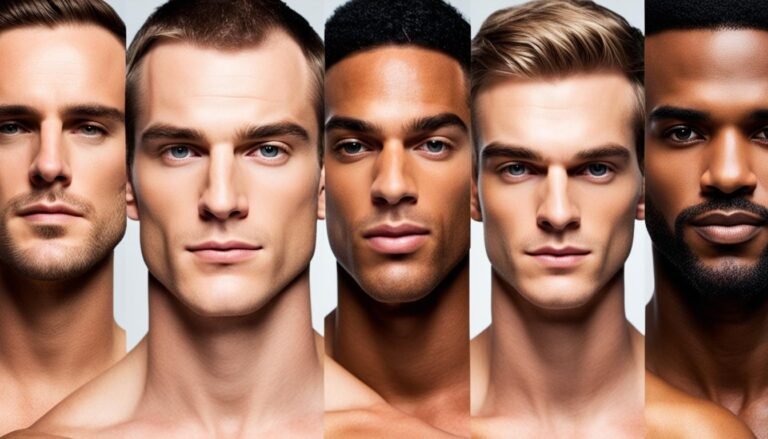Is Yellow skin attractive?
When it comes to attractiveness, we often focus on features like facial symmetry or body shape. But have you ever considered the role of skin color in perceptions of beauty? It turns out that a light, yellowish complexion may be more appealing than you think.
According to a study on facial skin color among Caucasians, a yellowish skin tone is not only considered attractive but also a sign of good health. Researchers found that individuals with a slightly yellow tint to their skin were perceived as healthier and more attractive compared to those with other skin tones.
But why is yellow skin considered attractive? And what does it say about our overall facial appearance? Join us as we delve into the fascinating world of skin color and uncover the surprising truths about attractiveness and yellow skin.
Key Takeaways:
- A light, yellowish complexion is believed to be the healthiest and most attractive among Caucasians.
- Yellow skin may be an indicator of a healthy diet rich in fruits and vegetables.
- Carotenoid pigments from these foods are known to have antioxidant properties and contribute to a healthy immune system.
- Skin color plays a significant role in perceptions of attractiveness, along with factors like face shape and symmetry.
- Understanding the importance of skin color can help individuals make informed decisions about lifestyle and diet to enhance their facial appearance.
The Impact of Skin Color on Attractiveness
Skin color is a highly variable characteristic of the face that can greatly influence perceptions of attractiveness. In a study conducted on Caucasian participants, individuals were asked to manipulate the skin color of male and female faces to make them appear as healthy as possible. The results showed that participants consistently increased the yellowness and brightness of the skin, suggesting a preference for a more golden or yellow-toned complexion. This preference is believed to be related to the presence of carotenoid pigments, which are found in fruits and vegetables and are known to have health benefits.
The research indicates that skin color plays a significant role in attractiveness judgments, highlighting the importance of maintaining a healthy lifestyle and diet for optimal facial appearance.
In a study on facial skin color among Caucasians, it was found that a light, yellowish complexion is perceived as the healthiest and most attractive. This color is believed to be an indicator of a healthy diet rich in fruits and vegetables. The preference for yellow-toned skin is thought to be linked to the presence of carotenoid pigments, which have antioxidant properties and contribute to a healthy immune system. Skin color, along with other factors such as face shape and symmetry, plays a significant role in perceptions of attractiveness.
Understanding the connection between skin color and attractiveness can shed light on the importance of maintaining a healthy lifestyle and a diet that includes foods rich in carotenoid pigments.
The Role of Skin Color in Mate Selection
Skin color plays a significant role in the process of mate selection. Studies have found that both carotenoid coloration and melanin coloration, which contribute to skin yellowness, enhance perceived health and attractiveness in Caucasian individuals. When examining levels of carotenoid and melanin coloration in controlled facial stimuli, both were found to be attractive compared to lower levels of these pigments. However, when the levels of coloration were matched, carotenoid coloration consistently emerged as the preferred choice over melanin coloration. These preferences were found to vary based on gender, with a stronger inclination towards carotenoid coloration in female faces.
The findings suggest that skin coloration plays a crucial role in mate choice and may reflect preferences for sex-typical coloration. The presence of carotenoid and melanin pigments in the skin provides visual cues associated with health and vitality, making individuals with higher levels of coloration more appealing as potential mates. This preference for skin color is believed to be driven by evolutionary factors, as it can serve as an indicator of genetic fitness and reproductive success.
Carotenoid coloration, in particular, has been linked to diet and lifestyle factors. Fruits and vegetables rich in carotenoids, such as carrots, tomatoes, and spinach, have been shown to enhance skin yellowness and attractiveness. These foods contain antioxidant properties and contribute to a healthy immune system, which may explain the preference for individuals with higher levels of carotenoid coloration.
“Skin coloration plays a significant role in mate choice and is associated with preferences for sex-typical coloration.”
The Impact of Skin Color on Mate Selection
Research has found that skin color is a significant factor in the mate selection process, with individuals showcasing preferences for specific coloration that is associated with attractiveness and health. The variation in skin color, contributed by carotenoid and melanin pigments, can influence perceptions of genetic fitness and reproductive potential, shaping decisions regarding potential partners.
| Factors | Preferences |
|---|---|
| Carotenoid Coloration | Preferred over melanin coloration when levels are matched |
| Melanin Coloration | Attractive but preferred less than carotenoid coloration |
| Gender Differences | Stronger preference for carotenoid coloration in female faces |
The findings highlight the importance of skin color in mate selection and its association with preferences for sex-typical coloration. Individuals with higher levels of carotenoid and melanin coloration are perceived as more attractive and healthier, making them more desirable as potential mates.

Understanding the role of skin color in mate selection can provide valuable insights into the complex dynamics of human attraction. It underscores the impact of evolutionary factors and highlights the importance of maintaining a healthy lifestyle and diet to enhance one’s facial appearance and increase the likelihood of attracting a potential mate.
The Impact of Skin Color on Perceptions of Beauty
Research indicates that skin color plays a crucial role in perceptions of beauty and attractiveness. A light, yellowish complexion is generally considered the healthiest and is associated with a diet rich in fruits and vegetables. The presence of carotenoid pigments in these foods contributes to the yellow-toned appearance of the skin, which is seen as a sign of good health.
While both carotenoid coloration and melanin coloration are attractive, preferences tend to favor higher levels of carotenoid coloration. This preference for yellow skin may be linked to the health benefits associated with carotenoids, such as antioxidant properties and immune system support. Understanding the importance of skin color in attractiveness can help individuals make informed decisions about their lifestyle and diet to enhance their facial appearance.
By prioritizing a diet rich in fruits and vegetables, individuals can optimize their skin color and promote a healthier complexion. Additionally, taking care of one’s skin through proper skincare routines, protection from sun exposure, and adequate hydration can further support a vibrant and attractive appearance. Embracing diversity in skin color and promoting inclusive beauty standards can contribute to a more inclusive and accepting society. Ultimately, beauty comes in a range of skin colors and celebrating this diversity is key to creating a more inclusive perception of beauty.






